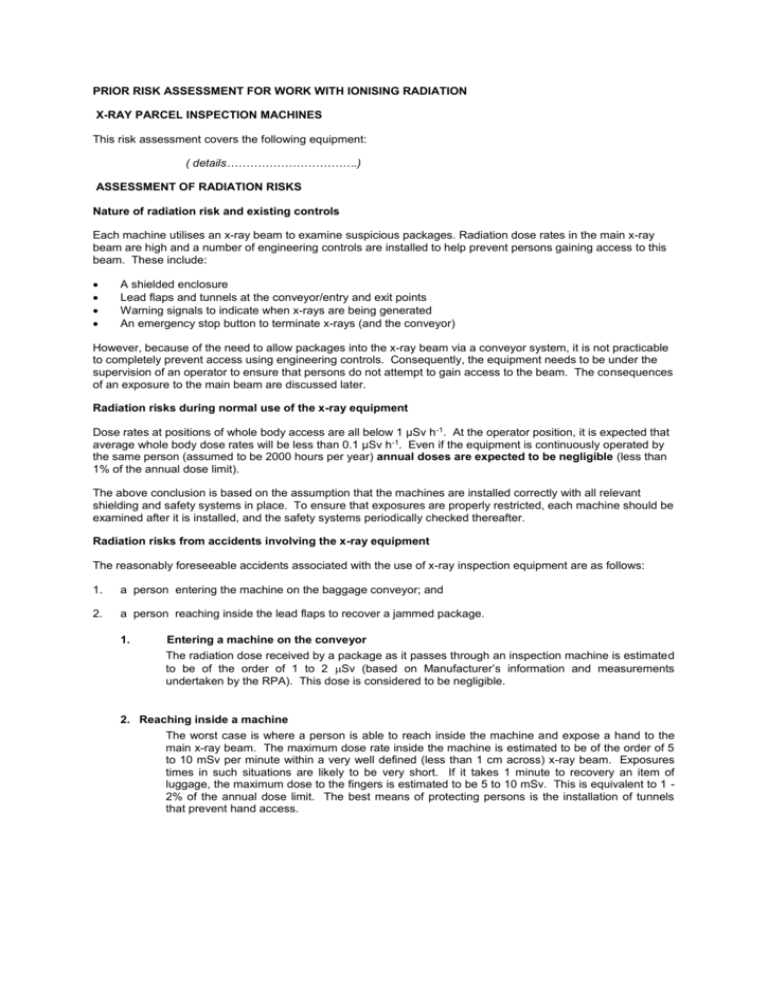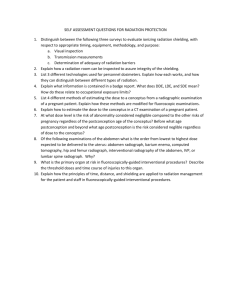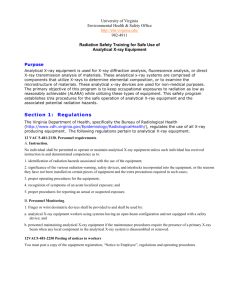X-ray parcel machines - University of Warwick
advertisement

PRIOR RISK ASSESSMENT FOR WORK WITH IONISING RADIATION X-RAY PARCEL INSPECTION MACHINES This risk assessment covers the following equipment: ( details…………………………….) ASSESSMENT OF RADIATION RISKS Nature of radiation risk and existing controls Each machine utilises an x-ray beam to examine suspicious packages. Radiation dose rates in the main x-ray beam are high and a number of engineering controls are installed to help prevent persons gaining access to this beam. These include: A shielded enclosure Lead flaps and tunnels at the conveyor/entry and exit points Warning signals to indicate when x-rays are being generated An emergency stop button to terminate x-rays (and the conveyor) However, because of the need to allow packages into the x-ray beam via a conveyor system, it is not practicable to completely prevent access using engineering controls. Consequently, the equipment needs to be under the supervision of an operator to ensure that persons do not attempt to gain access to the beam. The consequences of an exposure to the main beam are discussed later. Radiation risks during normal use of the x-ray equipment Dose rates at positions of whole body access are all below 1 μSv h -1. At the operator position, it is expected that average whole body dose rates will be less than 0.1 μSv h-1. Even if the equipment is continuously operated by the same person (assumed to be 2000 hours per year) annual doses are expected to be negligible (less than 1% of the annual dose limit). The above conclusion is based on the assumption that the machines are installed correctly with all relevant shielding and safety systems in place. To ensure that exposures are properly restricted, each machine should be examined after it is installed, and the safety systems periodically checked thereafter. Radiation risks from accidents involving the x-ray equipment The reasonably foreseeable accidents associated with the use of x-ray inspection equipment are as follows: 1. a person entering the machine on the baggage conveyor; and 2. a person reaching inside the lead flaps to recover a jammed package. 1. Entering a machine on the conveyor The radiation dose received by a package as it passes through an inspection machine is estimated to be of the order of 1 to 2 Sv (based on Manufacturer’s information and measurements undertaken by the RPA). This dose is considered to be negligible. 2. Reaching inside a machine The worst case is where a person is able to reach inside the machine and expose a hand to the main x-ray beam. The maximum dose rate inside the machine is estimated to be of the order of 5 to 10 mSv per minute within a very well defined (less than 1 cm across) x-ray beam. Exposures times in such situations are likely to be very short. If it takes 1 minute to recovery an item of luggage, the maximum dose to the fingers is estimated to be 5 to 10 mSv. This is equivalent to 1 2% of the annual dose limit. The best means of protecting persons is the installation of tunnels that prevent hand access. RECOMMENDED ACTIONS (Requirements of Ionising Radiations Regulations 1999) Restriction of exposure (Regulation 8) The following actions are considered necessary to ensure that radiation exposure is as low as reasonably practicable (ALARP): All new equipment should be subject to a critical examination by the suppliers to ensure that adequate radiation safety and waning systems are installed. The safety and warning systems should be periodically checked to ensure that they are still satisfactory. When energised, x-ray equipment must be continually supervised by a competent operator to prevent persons from entering or reaching inside the machine. Any maintenance work should only be carried out by trained engineers. Investigation level Under normal operating conditions, radiation doses are expected to be negligible. Any suspected abnormal exposure should, therefore, be investigated. For the purposes of Regulation 8 of the Ionising Radiations Regulations 1999, a formal investigation level of 1 mSv/y. Additional engineering controls and personal protective equipment It is not considered that any further controls or systems (apart from the tunnels described previously) are required to restrict exposure. There is no requirement for personal protective equipment to further reduce exposure. Designation of areas IRR99 require a radiation controlled area to be designated where there is the potential to receive doses in excess of three-tenths of the annual dose limit, or where special procedures are required to restrict exposures. High dose rates exist inside the inspection systems and, despite the installed safety systems, access to the x-ray beam is still possible. Consequently, the area inside the lead/plastic flaps is designated as a controlled area when the equipment is in a state of readiness to produce x-rays. Local rules and Radiation Protection Supervisor (RPS) The presence of a controlled area means that local rules should be provided. Simple rules (attached to the equipment) for machine operators are considered appropriate. Example rules are given at the end of this assessment. An RPS should be appointed to oversee compliance with the local rules. Arrangements for female employees Exposure of persons is expected to be negligible and no special precautions for female employees are considered necessary. Classified persons and personal dosimetry Individual doses are expected to be negligible and there is no requirement to designate any employee as a classified person. Accidental exposures are very unlikely and might easily not be detected by personal dosemeters. As such, personal dosemeters might give false reassurance, and are not considered appropriate. The most likely accident involving whole body exposure is where a person travels through the machine on the conveyor. This should be immediately apparent. For example, hand exposures (i.e. from a person reaching inside the machine) would not be detected by a dosemeter worn on the trunk. Radiation monitoring and safety checks The following checks are considered appropriate once every three months: A visual examination to check that: lead/plastic flaps and tunnels are in good condition; warning lights and emergency stops are functioning correctly; and that warning notices and local rules are present and clearly visible. Using a suitable radiation monitor: check dose rates around the equipment. The dose rates should not exceed: 1 μSv/h at positions of whole body access 25 μSv/h in any other position (e.g. extreme hand access) The results of all these checks should be recorded and kept for at least 2 years. EXAMPLE LOCAL RULES LOCAL RULES FOR OPERATORS OF BAGGAGE INSPECTION SYSTEMS (IONISING RADIATIONS REGULATIONS 1999) 1. The inside of the cabinet, within the lead/plastic curtains is a controlled radiation area whenever the unit is capable of producing x-rays. 2. No-one should enter or reach beyond the flaps (e.g. to retrieve baggage), until the inspection system has been switched off at the control console. 3. Baggage inspection systems may only be operated by persons specifically trained in the proper use of such equipment. Staff should not operate the equipment if they suspect if is faulty. Defects must be immediately reported to <>. 4. A Radiation Protection Supervisor (RPS) for this equipment has been appointed, as follows : Insert name and extension number 5. The RPS will arrange for safety checks on this equipment. Once every three months. These checks will confirm that all the safety systems are working correctly, and that there is no x-ray leakage. 6. The RPS must be informed if it is suspected that persons have been exposed to x-rays inside the cabinet. 7. In the event of any suspected incident or accident where a person might have received an x-ray exposure: The equipment should be isolated from the main power supply The RPS must be informed The RPS will carry out an investigation in consultation with the University RPO







